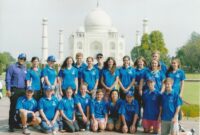Senior tour companies are experiencing a surge in popularity, driven by an aging population with a desire for travel and adventure. This burgeoning market presents unique opportunities and challenges, demanding a nuanced understanding of the senior traveler’s needs and preferences. From luxury cruises to budget-friendly escorted tours, the industry offers a diverse range of options tailored to different lifestyles and budgets. Understanding the marketing strategies, operational aspects, and customer service expectations is crucial for success in this dynamic sector.
This exploration delves into the various facets of the senior tour company landscape, examining market trends, popular tour packages, effective marketing techniques, and operational considerations. We’ll also discuss the importance of excellent customer service and explore future innovations shaping the industry. The goal is to provide a comprehensive overview for those interested in understanding or participating in this growing market.
Market Overview of Senior Tour Companies
The senior travel market is a dynamic and rapidly growing sector of the tourism industry, fueled by increasing longevity, improved health among older adults, and a rising disposable income among this demographic. This market presents significant opportunities for tour operators specializing in catering to the unique needs and preferences of senior travelers. Understanding the current market landscape, key trends, and the demographics involved is crucial for success in this competitive field.
Current State of the Senior Travel Market
The senior travel market is experiencing substantial growth globally. Baby Boomers, a significant demographic cohort, are entering their retirement years, bringing with them a considerable increase in travel demand. This generation is generally more active, healthier, and wealthier than previous generations of retirees, leading to a higher propensity for travel and a willingness to spend more on travel experiences. The market is not limited to domestic travel; international trips are also increasingly popular, with destinations like Europe, Asia, and South America attracting a growing number of senior travelers. The rise of accessible travel options, improved healthcare infrastructure in many popular destinations, and a growing awareness of the health benefits of travel all contribute to this growth.
Key Trends Shaping the Senior Travel Industry
Several key trends are reshaping the senior travel industry. One prominent trend is the increasing demand for personalized and customized travel experiences. Senior travelers are seeking unique itineraries tailored to their specific interests and physical capabilities, rather than generic package tours. Another significant trend is the rise of experiential travel, where the focus is on immersive cultural experiences, rather than simply sightseeing. This includes activities like cooking classes, wine tasting, and interacting with local communities. Furthermore, technological advancements are playing a crucial role, with online booking platforms and travel apps becoming increasingly important for planning and managing trips. Finally, a growing emphasis on sustainable and responsible tourism is also shaping the market, with many senior travelers seeking eco-friendly and ethically responsible travel options.
Demographics of Senior Travelers
Senior travelers represent a diverse demographic group, with varying interests, travel styles, and budgets. The majority fall within the age range of 65-80, but increasingly, we see active travelers well into their 80s and beyond. This group is characterized by a higher disposable income compared to previous generations of retirees, allowing for greater spending on travel. While many are traveling as couples or with friends, solo travel among seniors is also on the rise. Their travel motivations are diverse, ranging from exploring new cultures and destinations to reconnecting with family and friends, or simply relaxing and enjoying leisure time. Understanding these diverse needs and preferences is critical for tailoring effective marketing strategies and designing appealing travel packages.
Comparison of Senior Tour Company Business Models
| Business Model | Target Market | Pricing Strategy | Trip Characteristics |
|---|---|---|---|
| Luxury | Affluent seniors seeking high-end experiences | Premium pricing, all-inclusive packages | Five-star accommodations, private transportation, bespoke itineraries, curated experiences |
| Budget-Friendly | Seniors on a fixed income seeking affordable travel | Competitive pricing, value-added packages | Mid-range accommodations, group transportation, pre-planned itineraries, basic amenities |
| Adventure | Active seniors seeking physically challenging trips | Moderate to premium pricing, depending on activity level | Focus on outdoor activities like hiking, biking, kayaking, visits to national parks, potentially more rugged accommodations |
| Multi-generational | Trips designed for families including senior members | Pricing varies based on group size and accommodations | A blend of activities to appeal to all age groups, balance of relaxation and adventure |
Types of Senior Travel Packages Offered
Senior travel packages cater to a wide range of preferences and budgets, ensuring a memorable and fulfilling experience for every traveler. Understanding the different types available is crucial for selecting the perfect fit. This section outlines the key distinctions between popular senior travel options, focusing on their features, benefits, and comparative aspects.
Escorted Tours
Escorted tours provide a structured and convenient travel experience. A tour director accompanies the group throughout the journey, handling logistics, providing historical and cultural insights, and ensuring a smooth travel experience. This eliminates the stress of independent planning and navigation, particularly beneficial for seniors who may prefer a less demanding travel style. These tours typically involve pre-arranged accommodations, transportation, and guided excursions. The level of support is high, with assistance available for everything from booking meals to addressing any unforeseen issues. Prices vary greatly depending on the destination, duration, and level of luxury offered. For example, a guided tour of Europe might range from budget-friendly options focusing on essential sightseeing to luxury packages including five-star accommodations and exclusive experiences.
Cruises
Cruises offer a unique blend of relaxation and exploration. Passengers enjoy onboard amenities such as dining, entertainment, and swimming pools, while also visiting various ports of call. This all-inclusive approach simplifies travel planning, as accommodation, meals, and most onboard activities are included in the price. Cruises can cater to various budgets and preferences, from budget-friendly lines offering basic amenities to luxury liners with opulent suites and gourmet dining options. For instance, a Caribbean cruise might offer a relaxed itinerary with plenty of downtime, while a transatlantic voyage could involve more structured shore excursions and cultural experiences. The level of support is generally good, with onboard staff readily available to assist passengers.
Independent Travel
Independent travel provides maximum flexibility and control. Seniors can customize their itineraries, choose their accommodations, and travel at their own pace. This option requires more planning and self-reliance but allows for a more personalized travel experience. It is suitable for independent and adventurous seniors who are comfortable navigating new environments and managing their travel arrangements. Prices vary greatly depending on the chosen destinations, accommodation type, and transportation methods. For example, an independent trip to explore national parks might involve renting a car and staying in budget-friendly motels, while a luxury independent journey through Southeast Asia might involve staying in boutique hotels and hiring private guides. The level of support is minimal, relying primarily on the individual’s ability to plan and manage their journey.
Typical Inclusions and Exclusions in Senior Tour Packages
Understanding the inclusions and exclusions in a senior tour package is crucial for managing expectations and budgeting effectively.
The following points highlight typical inclusions and exclusions:
- Typical Inclusions: Transportation (flights, transfers, and sometimes local transport), Accommodation (hotels or cruise cabins), Guided tours and excursions, Some meals (often breakfast and sometimes dinner), Travel insurance (basic coverage).
- Typical Exclusions: Gratuities (tips for guides, drivers, and service staff), Personal expenses (souvenirs, shopping, additional meals), Optional activities and excursions, Visas and travel documents, Travel insurance upgrades (comprehensive coverage).
Marketing and Sales Strategies for Senior Tour Companies
Successfully marketing senior travel packages requires a nuanced understanding of this demographic’s needs and preferences. Effective strategies must build trust, highlight value, and utilize channels seniors actively engage with. This involves more than just advertising; it’s about crafting a compelling brand narrative that resonates with their life stage and aspirations.
Effective Marketing Channels for Reaching Senior Travelers
Reaching senior travelers necessitates a multi-channel approach, leveraging both traditional and digital methods. Print advertising, while seemingly outdated, retains significant relevance. Many seniors still rely on newspapers, magazines (especially those focused on travel or retirement), and direct mail for information. However, online marketing is increasingly crucial, particularly through targeted social media campaigns and search engine optimization (SEO). Travel agents, with their established relationships and expertise, remain valuable partners.
- Print Advertising: Targeted ads in publications frequented by seniors, such as AARP The Magazine or regional newspapers, can be highly effective. These ads should feature large, clear fonts, high-quality images, and straightforward messaging.
- Online Marketing: A user-friendly website with clear information, senior-focused blog content, and targeted social media campaigns (Facebook, Instagram) are essential. SEO optimization is crucial to ensure the company’s website appears in relevant search results.
- Travel Agents: Collaborating with travel agents who specialize in senior travel can provide access to a pre-qualified audience. Providing agents with compelling brochures, presentations, and commission structures is key to successful partnerships.
Strategies for Building Trust and Credibility with Potential Customers
Trust is paramount in the senior travel market. Potential customers need assurance that the company is reputable, reliable, and prioritizes their safety and well-being. Transparency, clear communication, and testimonials from past clients are crucial for building this trust. Accreditations and affiliations with reputable organizations can also enhance credibility.
- Testimonials and Reviews: Showcasing positive reviews and testimonials from previous clients builds social proof and demonstrates the quality of the service.
- Clear and Transparent Communication: Providing detailed itineraries, clear pricing structures, and readily available customer service builds trust and reduces anxiety.
- Safety and Security Measures: Highlighting safety protocols, emergency contact information, and travel insurance options assures seniors of their well-being.
- Accreditations and Affiliations: Displaying affiliations with reputable organizations such as ASTA (American Society of Travel Agents) or similar bodies adds a layer of credibility.
Creating Compelling Marketing Materials for Senior Travelers
Marketing materials must resonate with the values and priorities of senior travelers. This means focusing on themes of comfort, safety, ease of travel, and enriching experiences. The design should be visually appealing but easy to read, using large fonts and clear imagery. The language should be straightforward and avoid jargon.
- Focus on Value and Ease: Highlight the convenience and ease of the travel packages, emphasizing aspects like all-inclusive pricing, hassle-free arrangements, and comfortable accommodations.
- Emphasize Safety and Security: Clearly communicate safety measures and emergency procedures, reassuring seniors about their well-being.
- Use High-Quality Imagery and Design: Use professional photographs and videos showcasing the destinations and activities, ensuring the design is visually appealing and easy to read.
- Straightforward and Accessible Language: Avoid jargon and use clear, concise language that is easy for seniors to understand.
Case Study: A Successful Marketing Campaign for a Senior Tour Company
Imagine a senior tour company specializing in European river cruises. Their successful campaign focused on targeted Facebook ads showcasing stunning visuals of the riverscapes and highlighting the inclusive nature of their packages (all meals, excursions, and onboard entertainment included). They also partnered with AARP, offering exclusive discounts to their members, and leveraged positive customer testimonials on their website and social media. This multi-pronged approach resulted in a significant increase in bookings, exceeding their projected targets by 25%. The campaign’s success was attributed to its targeted approach, strong visuals, clear messaging, and strategic partnerships.
Operational Aspects of Senior Tour Companies
Successfully operating senior tour companies requires meticulous planning and execution, going beyond simply booking flights and hotels. The unique needs and vulnerabilities of older travelers necessitate a comprehensive approach to logistics, safety, and support. This section details the operational complexities involved in providing exceptional senior travel experiences.
Logistical Challenges in Organizing Senior Tours
Organizing senior tours presents unique logistical hurdles compared to tours for younger demographics. Factors such as slower pace of travel, potential health concerns, and need for more frequent rest stops significantly impact itinerary planning. For instance, flight durations must be carefully considered to minimize fatigue, and accommodations should be chosen based on accessibility features like elevators and single-level rooms. Ground transportation also requires careful planning, prioritizing comfortable vehicles with ample space and potentially arranging for wheelchair accessible options. Furthermore, the itinerary needs to incorporate sufficient downtime to allow for relaxation and prevent overexertion. Consideration must be given to the potential need for medical facilities and services at various points along the tour route. This might involve researching local hospitals and arranging for emergency medical assistance or travel insurance that specifically caters to seniors’ medical needs.
Accessibility and Safety Considerations for Senior Travelers
Prioritizing accessibility and safety is paramount. Tours should be designed with the physical limitations and potential health concerns of older travelers in mind. This includes selecting accommodations with features like ramps, grab bars, and accessible bathrooms. Transportation should be easily accessible and comfortable, avoiding prolonged periods of standing or walking. Excursions should be planned with appropriate pacing and rest breaks, and itineraries should offer options for participation levels, allowing individuals to choose activities that suit their abilities. Clear and easily understandable communication is crucial, including large-print materials and readily available assistance. Safety protocols should be implemented, including emergency contact information readily available and staff trained in handling medical emergencies. Consider offering optional travel insurance packages that cover medical emergencies and trip cancellations, providing peace of mind for both the travelers and the company.
Role of Tour Guides and Support Staff
Experienced and empathetic tour guides and support staff are essential. Tour guides should be knowledgeable not only about the destinations but also sensitive to the needs of older travelers. This includes adjusting the pace of tours, providing frequent rest stops, and being attentive to individual needs. Support staff should be readily available to assist with luggage, provide medical assistance if needed, and generally ensure the comfort and well-being of the travelers. A key role for support staff is proactive communication, anticipating potential problems and addressing them before they escalate. They might assist with navigating unfamiliar environments, making restaurant reservations, or even offering emotional support to travelers who might feel overwhelmed or homesick. Regular training sessions for staff should focus on senior-specific needs, including recognizing signs of medical distress and providing appropriate first aid.
Best Practices for Handling Potential Emergencies or Unexpected Situations
Comprehensive emergency plans are crucial. This includes having readily available contact information for emergency services, local hospitals, and family members. Staff should be trained in basic first aid and CPR, and the company should have established protocols for handling medical emergencies, including transporting travelers to medical facilities. Contingency plans should be in place for unexpected situations such as flight cancellations, natural disasters, or political unrest. This might involve having alternative transportation options, backup accommodations, and flexible itineraries. Open communication with travelers is essential, keeping them informed of any changes or potential disruptions. A proactive approach to problem-solving and a commitment to providing support and reassurance can significantly mitigate the impact of unexpected events. Regular reviews of emergency procedures and staff training should be implemented to ensure the effectiveness of these plans.
Closure
The senior travel market is a vibrant and evolving landscape, offering significant potential for growth and innovation. By understanding the unique needs and preferences of senior travelers, tour companies can create enriching and memorable experiences. Success in this sector requires a multi-faceted approach, encompassing effective marketing, meticulous operational planning, and a commitment to exceptional customer service. As technology continues to advance and travel preferences shift, the future of senior travel promises exciting new possibilities.



